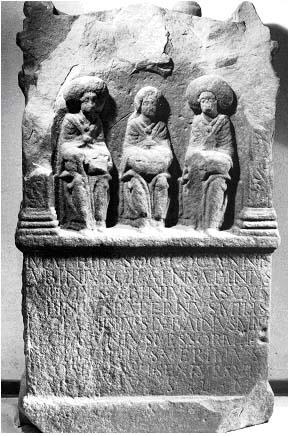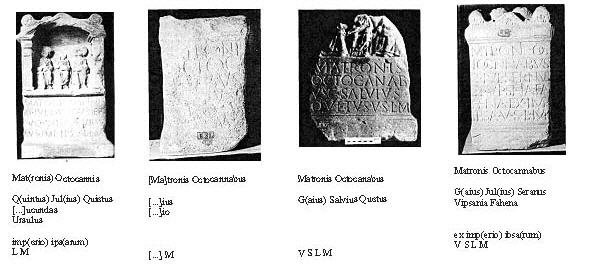Krefeld: Matronae Octocannae
Krefeld: Matronae Octocannae
Krefeld: Matronae Octocannae
By Marjorie Harrison Weiss
This votive altar, now in the Museum Burg-Linn in Krefeld, was discovered in 1977 while quarrying gravel in a dock area along the Rhine river. This, as it happened, was in the vicinity of the Roman military outpost Gelduba. The stone is 1.20 m high and made of gray-white sandstone. Traces of mortar found on the stone give rise to speculation that the stone was re-used in the defensive wall built around the compound. The stone is dated to the first half of the 3rd century (200-250AD).
The carving on the front depicts the same iconography found on votive altars to the Matrons in the Eifel. Three women seated on a bench with baskets on their laps. These are filled with something, but are so weathered that the contents cannot be identified exactly. All three wear necklaces with crescent shaped pendants and Ubi style clothes. The two outer women wear the typical voluminous, crescent shaped head covering. The younger woman in the middle wears her hair loose. The goddess on the right is holding a flower in her right hand.
Matronen Krefeld

Krefeld2
Both sides of this altar were carved in low relief. In the intervening centuries, either natural weathering or wilful destruction (or a combination of both) left all the sculpting badly damaged. The figures and their attributes are very ill defined. Facial features have been completely erased and exact details of dress are nearly indistinguishable. However, on the right side at the top, it is still possible to make out a female with shoulder length hair, holding a long hanging object in either hand. Comparison with better preserved sculpting on other votive altars (like the ones in Bonn), makes it possible to assume that the hanging objects are garlands of flowers. The woman is standing on a capital between two square columns under a lintel. She is, perhaps, a temple servant or perhaps one of the patrons who commissioned the altar. She is thought to be helping with the rites honoring the goddesses shown on the front.
At the bottom of the right side is a diagonal lance (hasta) behind a round shield (parma), standard issue weapons of Roman soldiers.
On the left side, is a male figure. He is wearing a short tunic and also standing on a capital between columns under a lintel. Again, the details are nearly lost. The head and face, as well as the upper arms and hands are all missing. He is possibly a temple servant or perhaps one of the altar’s patrons. On the left bottom is a Hercules’ club - a standard issue Roman weapon.
Beneath the goddesses on the front of the stone, is an inscription. It is relatively long, providing far more text – mostly names – than other inscriptions. The surface is nearly indecipherable. Nonetheless, two attempts have been published. The now accepted inscription reads:
Matribus Octocannis/
Albinius Gratinus Albinius/
Albulus Albinius Ursulus/
Albinius Paternus milis (!)/
[O]glannius Lubainus mil(es)/
[O]glannius Messor milis (!)/
...]issinius Verinus/
pro se et suis ex iussu ip/
sarum v(ota) s(olverunt) l(ibentes) m(erito)
This altar is dedicated to the 'Matribus Octocannis' a designation only known from it and four other votive altars originally found in a temple compound in the small community of Ossum, not far from Krefeld. Octocannis is, here, the name-extension of the Matrons. The inscription contains other names, too. This votive altar was dedicated by seven males - all Roman citizens. Four of them were called Albinius, and thus, appear to have been related to each other in some way. Three call themselves soldiers. All are named individually. The inscription is very badly weathered and very difficult to read exactly, leaving room for more than one possible interpretation. The name Albinius is quite common in the Roman world, especially in the province of Dacia. Another transcription has suggested the reading ‘Paternus milis Daci etc” which clearly places the soldiers as coming from there. Albinius could also refer in some way to M. Nummius Umbrius Primus Senecio Albinus, one of the consuls in 206 AD, since this coincides with the approximate date of the altar.
It is also possible that if the name, ‘Albi’ is a name stem, it might refer to a location nearer by. Four votive altars have been found dedicated to the Matronae Albiahenae around Ober-Elvenich near Zuelpich. A forerunner to the current spelling of Elvenich, is Albiniacum. The ending ‘ahenae’ occasionally appears as an adjective ending. This would leave ‘Albi’ as the stem, with perhaps a connection to Albiniacum.
Perhaps the Albinius’ from the Krefeld altar, are also Albi from Albiniacum . These Albi are often associated with veterans from Dacia, another explanation could associate them with the recently defeated and enslaved Albians from Britain. Perhaps they are not from Dacia, but from near-by Ober-Elvenich, where others of their kinship group also dedicated votive altars to the Matrons.
In addition to the votive altar in Krefeld, there are four other votive altars dedicated to the Matrons of Octocannae. These are now in Bonn at the Rheinische Landesmuseum and were described by Lehner. Two of these have sculpted images. One of these is badly weathered. Two have inscriptions, but no depictions of the three goddesses. (see graphic following)
4Matronen
